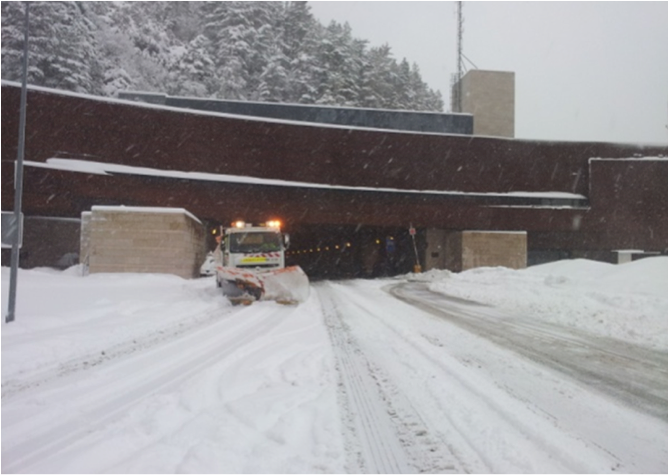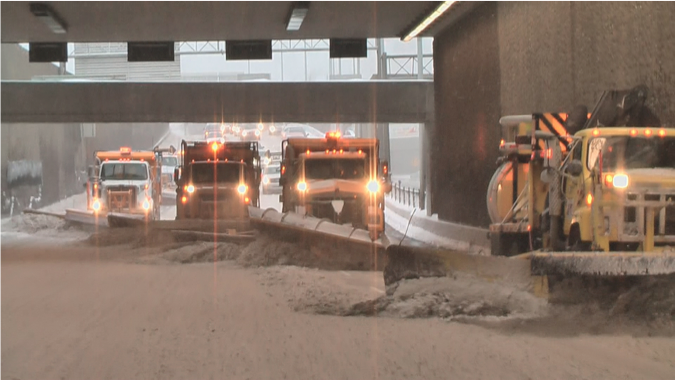Winter maintenance
- 1. Introduction
- 2. Considerations
- 3. Problems, Preventive actions, Corrective actions and Constraints
- 4. Construction and design considerations
- 5. References
- 6. Presentations made during PIARC Winter Road Congresses
1. Introduction

2. CONSIDERATIONS
The considerations that impact the winter serviceability of road tunnels are both numerous and varied. The operator, whose mission is to ensure user safety, must therefore make every effort to counter the adverse effects of winter as well as ensure that users benefit from safe conditions in circumstances that are sometimes very difficult, such as extreme weather events. The operator must adequately coordinate its tunnel de-icing and snow-clearing teams, which can be challenging and slow in busy traffic. Visibility in tunnels further decreases during the winter months, as lighting fixtures become dirty and due to the spray deposits along the walls, which also affect surveillance cameras and air quality sensors. The operator must assure the operational availability of all safety and fire protection equipment, which must also be protected from freezing.

Communications make it possible to transmit information in order to facilitate the management of difficult situations. At all times, the operator must provide useful information to the media in order to quickly inform users of road conditions, closures and snow removal operations. In a transport organisation, efficient communications structured in a well-defined decision-making hierarchy make it possible to effectively manage extreme weather events that require major decisions, such as lane or tunnel closures, whether for safety reasons or de-icing operations.
3. PROBLEMS, PREVENTIVE ACTIONS, CORRECTIVE ACTIONS AND CONSTRAINTS
Table 1 below presents a list of the particular problems inherent to the winter conditions that road tunnel operators must face. It also presents a non-exhaustive list of preventive and corrective actions, in addition to the usual constraints that operators must deal with when conducting operations.
| Problem | Preventive actions | Corrective maintenance | Constraints |
|---|---|---|---|
Water infiltration | - Program to identify and seal leaks and infiltration - Monitor waterproof joints |
- Manage infiltrations - Install heated temporary pipes - Repair waterproof joints
| - Maintaining traffic flow - Heavy traffic periods - Permit to close lanes temporarily for maintenance (closures usually at night or on weekends) - Difficult work conditions in road tunnels |
Formation of icicles or stalactites | Locate icicles and stalactites and conduct de-icing operations as needed when user safety is compromised | - Availability of snow removal teams and equipment - Heavy traffic periods - Permit to close lanes temporarily for maintenance - Difficult work conditions in road tunnels | |
Frost or snow on the roadway - Unexpected slippery conditions in road tunnels - Motor vehicles and heavy vehicles have difficulty exiting tunnels during snowstorms, causing traffic slowdowns, traffic jams and accidents - Risk of skidding in sloped accesses, causing motorists to lose control, accidents | - Inspection of snow removal equipment after use and before storage - Application of de-icing agents when precipitations begin - Installation and use of roadway de-icing systems (heating cables, hydronic heating, etc.) at tunnel - Predictive diagnostics to preheat equipment that is sensitive to extreme cold | Remove and transport snow and apply de-icing agents (abrasives are to be avoided as they can block drain pipes) | - Budget - Availability of snow removal teams and equipment (24/7) - Heavy traffic periods - Permit to close lanes temporarily for maintenance - Restrictions on the use of de-icing agents (environmental impact, toxicity, storage and application precautions, recovery, transport and destruction) - Efficiency of de-icing agents relative to temperature - Risk of damage to the concrete structure caused by de-icing agents (e.g. salt). |
Debris and formation of ice in drain pipes | - Periodic inspection program - Clean pipes, bore holes as needed - Verify the operation of heating cables - Monitor low temperature alarms in protected systems | - Flush pipes - Remove ice in gutters - Bore holes in pipes as needed - Replace defective drainage components | - Maintaining traffic flow - Heavy traffic periods - Permit to close lanes temporarily for maintenance (closures usually at night or on weekends) - Difficult work conditions in road tunnels |
Accumulation of dirt on tunnel walls, ceiling and equipment, such as surveillance cameras, lighting fixtures, air quality sensors, signalling equipment, escape route indicators, etc. | - Visual inspections - Maintenance operations, including cleaning surveillance cameras, walls and lighting fixtures outside busy traffic hours | Maintenance operations, including cleaning surveillance cameras, walls and lighting fixtures outside busy traffic hours | - Low temperatures - Heavy traffic periods - Permit to close lanes temporarily for maintenance - Restrictions on the use of cleaning products (environmental impact, toxicity, storage and application precautions, recovery, transport and destruction) - Efficiency of cleaning products relative to temperature - Difficult work conditions in road tunnels |
Corrosion of doors, anchors, equipment, cable and equipment mounts | - Use of products and materials that are compatible with the aggressive environment in tunnels - Periodic inspection program - Use of stainless steel or composite components where applicable - Inspection and maintenance operations, including lubrification and/or rust protection | Replace rusted components and equipment as needed | - Standards applicable to road tunnels - Resistance to fire, water, humid and corrosive environments |
Cracking, fragmentation of concrete debris falling on the roadway, heaving of concrete slabs, contamination of concrete | - Waterproof membranes - Protective coatings - Periodic inspection program with damage and contamination surveys - Surface repairs | Repair the concrete Seal cracks Rehabilitate the infrastructure | Budget Permit to close temporarily for inspections Maintaining traffic flow during work Degraded modes of operation Measures to reduce impact on users Difficult work conditions in road tunnels |
Increased energy consumption during winter, peak power demand and impact on the electricity network Uneven between seasons and impact on billing | - Analyse and follow up energy consumption and peak power demand - Intelligent energy management system and measures to reduce demand - Selection of energy-efficient equipment - Use of alternative energy sources where possible and cost-effective - Storage of energy during low consumption periods to balance energy use - Technological watch | - Budget and cost-effectiveness of performance-enhancing solutions - Availability of space for required equipment (e.g. storage) - Availability of alternative energy sources - Resistance to changing operational and energy consumption habits - Laws, regulations, political pressure, sustainable development | |
Erratic operation of electronic equipment due to cold and humidity | - Use of products that are compatible with the cold, humid and aggressive environment in tunnels - Monitor alarms - Periodic operational tests and calibration | - Permit to close temporarily for inspections - Maintaining traffic flow during work - Degraded modes of operation - Measures to reduce impact on users - Difficult work conditions in tunnels | |
4. CONSTRUCTION AND DESIGN CONSIDERATIONS
Usually, the construction of roads through mountain ranges may require tunnels at high altitudes. Above 1.000 meters over sea level, special maintenance activities are required to provide acceptable traffic conditions inspite of the risk of snow or ice formation. This situation becomes critical in the proximity of tunnel portals.
At the north of the province of Huesca, in Spain, where several tunnels above 1.100 meters above sea level can be found, several important factors are to be considered to deal with temperatures which can go below -20ºC.
Water is the hardest enemy to fight: causing infiltration due to low temperatures, producing cracks and even spalling in vaults and side walls.
At the tunnel portal, an adequate construction of pavement and good quality of road painting are key factors for their durability. High quality materials are required because snow plough circulation and extreme meteorological conditions can cause their deterioration.
To fulfil the requirements of Rd635/2006, the transposition to the Spanish law of the European Directive 2004/54 on minimum requirements for road tunnels safety, several types of equipment must be installed which can be severely affected by malfunctioning or even breakdowns when needed.
Suspended power supply lines are exposed to ice formation which is the origin of outages which, if regular, can affect the durability of UPS and diesel generators.
Water tanks to supply fire hoses of the tunnel must be carefully constructed to avoid the appearance of cracks. In addition, continuous water circulation is advisable.
Water supply pipes must be protected with thermal protection and, if possible, emptied. Opening elements of fire hydrant and hoses can be also affected and the technical rooms containing pumping machinery should be above 0ºC.
In addition, proper maintenance of the vehicles used for operational and emergency purposes is crucial, including the use of adequate antifreeze products for motor and fuel and water tank protection.
And last but nor least, both the difficulties in the relief of the operation staff and appropriate clothing (not only warming or waterproof aspects but also visibility improvement) must be considered.
5. REFERENCES
- DEBS A., "Challenges related to winter operations in urban highway tunnels», reference RR361-076, AIPCR, 2014
- LÓPEZ GUARGA R., "Proyecto de las Instalaciones y Equipamientos del túnel de Somport. Parte española", Ministerio de Fomento, 1996
- DEBS A., "Winter operation of road tunnels in Quebec. The Ville-Marie and Louis-Hippolyte-Lafontaine tunnels", International Winter Road Congress, Quebec, 2010.
- V. LANGNER, B. HAGENAH, GRANER GUNBH (Autriche), T. CRONVALL, VR TRACK OY (Finland), "Ice formation. Aspects of planning and measures for climate impact", 15° International Symposium on Aerodynamics, Ventilation & Fire in Tunnels, Barcelona, September 2013.
- Agencia Estatal de Meteorología. Datos estadísticos
6. PRESENTATIONS MADE DURING PIARC WINTER ROAD CONGRESSES
- SCHMITZ P., "The C4 Committee and durable winter viability in the road tunnels"
- DEBS A., " Winter operation of road tunnels in Quebec. The Ville-Marie and Louis-Hippolyte-Lafontaine tunnels "
- DUANE HILL, "Winter operation and maintenance of tunnel in North Eastern Minnesota"
- ANDERSON P., "Water infiltration and ice problems in rock tunnels in Sweden"
- TRIAS Ch., "The Envalira tunnel in winter conditions"
- DEBS A., " Challenges related to winter operations in urban highway tunnels"
- LOPEZ GUARGA R., "Road tunnels in wintertime. Maintenance and operational challenges"
- DEL REY I., "Impact on users of not-noticeable extreme weather conditions in long road tunnels"
- LONGTIN P., "Road tunnel maintenance in winter condition: a solution to economic constraints and sustainable development"
- SUMESH NAIR, "Impact of cold tunnel environment on the performance of fire fighting equipment"
- PORTUGUES F., "Winter conditions in tunnel Bielsa-Aragnouet and upgraded safety"
- SANZ J.M., "Anti-frost system designed by Euroestudios for the fire suppression system of the AP-66 tunnels (toll motorway Campomanes - León)"
- TAKASHI SATO, "Investigation of evaluation and estimation of tunnel lining deterioration based on inspection data"
- SCHMITZ P., "The PIARC Road Tunnels Manual and Winter Maintenance"
- LONGTIN P., " Benefits of an advanced LED lighting control system for snowsheds located in intense avalanche areas".






